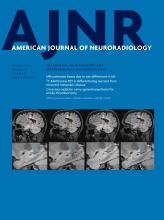Research ArticleAdult Brain
Differentiation between Treatment-Induced Necrosis and Recurrent Tumors in Patients with Metastatic Brain Tumors: Comparison among 11C-Methionine-PET, FDG-PET, MR Permeability Imaging, and MRI-ADC—Preliminary Results
N. Tomura, M. Kokubun, T. Saginoya, Y. Mizuno and Y. Kikuchi
American Journal of Neuroradiology August 2017, 38 (8) 1520-1527; DOI: https://doi.org/10.3174/ajnr.A5252
N. Tomura
aFrom the Departments of Neuroradiology, Radiology, and Neurosurgery, Southern Tohoku Research Institute for Neuroscience, Southern Tohoku General Hospital, Koriyama City, Fukushima, Japan.
M. Kokubun
aFrom the Departments of Neuroradiology, Radiology, and Neurosurgery, Southern Tohoku Research Institute for Neuroscience, Southern Tohoku General Hospital, Koriyama City, Fukushima, Japan.
T. Saginoya
aFrom the Departments of Neuroradiology, Radiology, and Neurosurgery, Southern Tohoku Research Institute for Neuroscience, Southern Tohoku General Hospital, Koriyama City, Fukushima, Japan.
Y. Mizuno
aFrom the Departments of Neuroradiology, Radiology, and Neurosurgery, Southern Tohoku Research Institute for Neuroscience, Southern Tohoku General Hospital, Koriyama City, Fukushima, Japan.
Y. Kikuchi
aFrom the Departments of Neuroradiology, Radiology, and Neurosurgery, Southern Tohoku Research Institute for Neuroscience, Southern Tohoku General Hospital, Koriyama City, Fukushima, Japan.

REFERENCES
- 1.↵
- Tsao MN,
- Mehta MP,
- Whelan TJ, et al
- 2.↵
- 3.↵
- Mehta MP,
- Tsao MN,
- Whelan TJ, et al
- 4.↵
- 5.↵
- 6.↵
- Fabiano AJ,
- Qiu J
- 7.↵
- Chang SD,
- Lee E,
- Sakamoto GT, et al
- 8.↵
- 9.↵
- 10.↵
- 11.↵
- Ou SH,
- Klempner SJ,
- Azada MC, et al
- 12.↵
- Valk PE,
- Dillon WP
- 13.↵
- 14.↵
- Chemov MF,
- Hayashi M,
- Izawa M, et al
- 15.↵
- Asao C,
- Korogi Y,
- Kitajima M, et al
- 16.↵
- 17.↵
- Jain R,
- Narang J,
- Schultz L, et al
- 18.↵
- Gómez-Río M,
- Martínez Del Valle Torres D,
- Rodríguez-Fernández A, et al
- 19.↵
- 20.↵
- Samnick S,
- Bader JB,
- Hellwig D, et al
- 21.↵
- Galldiks N,
- Stoffels G,
- Filss C, et al
- 22.↵
- 23.↵
- Lizarraga KJ,
- Allen-Auerbach M,
- Czernin J, et al
- 24.↵
- Kim EE,
- Chung SK,
- Haynie TP, et al
- 25.↵
- Di Chiro G,
- Oldfield E,
- Wright DC, et al
- 26.↵
- 27.↵
- 28.↵
- Tsuyuguchi N,
- Sunada I,
- Iwai Y, et al
- 29.↵
- Tsuyuguchi N,
- Takami T,
- Sunada I, et al
- 30.↵
- 31.↵
- Terakawa Y,
- Tsuyuguchi N,
- Iwai Y, et al
- 32.↵
- 33.↵
- Pauliah M,
- Saxena V,
- Haris M, et al
- 34.↵
- Wu S,
- Thornhill RE,
- Chen S, et al
- 35.↵
- Tofts PS,
- Brix G,
- Buckley DL, et al
- 36.↵
- 37.↵
- Yang S,
- Law M,
- Zagzag D, et al
- 38.↵
- Cha S,
- Yang L,
- Johnson G, et al
- 39.↵
- Lee SK,
- Kim E,
- Choi H
- 40.↵
- 41.↵
- Huang B,
- Wong CS,
- Whitcher B, et al
- 42.↵
- Kim YE,
- Lim JS,
- Choi J, et al
- 43.↵
- Verma S,
- Turkbey B,
- Muradyan N, et al
- 44.↵
- Narang J,
- Jain R,
- Arbab AS, et al
- 45.↵
- Tomura N,
- Ito Y,
- Matsuoka H, et al
- 46.↵
- Nuñez R,
- Macapinlac HA,
- Yeung HWD, et al
- 47.↵
- 48.↵
- Levivier M,
- Massager N,
- Wikler D, et al
- 49.↵
- Pirotte B,
- Goldman S,
- Massager N, et al
- 50.↵
- 51.↵
- Barajas RF Jr.,
- Chang JS,
- Segal MR, et al
- 52.↵
- 53.↵
- 54.↵
- Guo AC,
- Cummings TJ,
- Dash RC, et al
- 55.↵
- Conti PS,
- Lilien DL,
- Hawley K, et al
- 56.↵
- Hoh CK,
- Schiepers C,
- Seltzer MA, et al
In this issue
American Journal of Neuroradiology
Vol. 38, Issue 8
1 Aug 2017
Advertisement
N. Tomura, M. Kokubun, T. Saginoya, Y. Mizuno, Y. Kikuchi
Differentiation between Treatment-Induced Necrosis and Recurrent Tumors in Patients with Metastatic Brain Tumors: Comparison among 11C-Methionine-PET, FDG-PET, MR Permeability Imaging, and MRI-ADC—Preliminary Results
American Journal of Neuroradiology Aug 2017, 38 (8) 1520-1527; DOI: 10.3174/ajnr.A5252
0 Responses
Differentiation between Treatment-Induced Necrosis and Recurrent Tumors in Patients with Metastatic Brain Tumors: Comparison among 11C-Methionine-PET, FDG-PET, MR Permeability Imaging, and MRI-ADC—Preliminary Results
N. Tomura, M. Kokubun, T. Saginoya, Y. Mizuno, Y. Kikuchi
American Journal of Neuroradiology Aug 2017, 38 (8) 1520-1527; DOI: 10.3174/ajnr.A5252
Jump to section
Related Articles
- No related articles found.
Cited By...
- Utility of Amino Acid PET in the Differential Diagnosis of Recurrent Brain Metastases and Treatment-Related Changes: A Meta-analysis
- Diagnostic Accuracy of Amino Acid and FDG-PET in Differentiating Brain Metastasis Recurrence from Radionecrosis after Radiotherapy: A Systematic Review and Meta-Analysis
This article has not yet been cited by articles in journals that are participating in Crossref Cited-by Linking.
More in this TOC Section
Similar Articles
Advertisement











